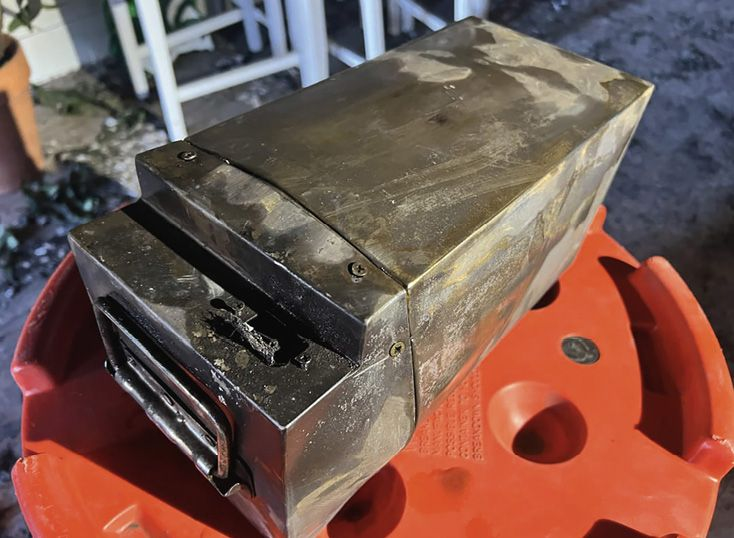From pv magazine print edition 3/24
Lithium ion battery energy storage systems (BESS’) have emerged as a dominant energy technology, with gigawatts of capacity installed annually. Analyst Wood Mackenzie has estimated the United States battery market alone could reach 75 GW by 2027. Utility scale grid connections and major technology companies including Google, Amazon, and Microsoft are driving demand as they seek reliable backup power. On site battery storage is becoming a priority for renewables developers keen to better match demand and to hedge against volatile energy prices.
The boom in demand has highlighted concern about potential fires and explosions at battery sites and has sparked debate about mitigation measures.
One approach is to leave BESS’ to freely consume, or “burn” through the stranded energy supply without active protection or suppression systems. This unused system capacity is susceptible to fire risk and with no suppression measures, could extend the duration and severity of a burn event.
Approaches to explosions and fire mitigation focus on spatial separation, robust battery management systems (BMS’), granular thermal runaway sensors, and explosion relief systems.
Mitigating fire risk became a major focus in 2017, following destructive fires in first-generation BESS’ that lacked fire protection or suppression. That prompted new asset-protection systems, with gaseous fire systems proving popular.
Gaseous suppression involves oxygen being removed from battery chambers to stop feeding fires. The other common approach involves spraying assets with water. Each has problems. Gaseous suppression risks reigniting fires with the introduction of oxygen, heightening explosion risk. Water-based systems are limited by the volume of water required to extinguish lengthy blazes.
The United States National Fire Protection Association (NFPA) released industry standards in 2017 recommending sprinkler systems for BESS fire protection. The argument for sprinklers was bolstered by a cascading thermal runaway event in Arizona in 2019 which saw a gaseous-based fire suppression system fail to stop thermal runaway gas generation, leading to explosive conditions in closed containers. The resulting updated standards required the use of sprinklers, with alternatives permitted only subject to approval by insurance companies and building-code officials.
Insurance considerations
The rapid evolution of the BESS industry makes life difficult for insurers, with property insurers considering the battery chemistry and the environment around a BESS. Single-layer BESS’ – versus stacked containers – and spatial separation of units can reduce premiums and client-related terms and conditions. Other factors include a robust BMS, predictive thermal runaway sensors, explosion relief systems, and the efficacy of fire department training programs. Such systems can influence how much project cost is covered by insurance policies.
Insurers and building code officials are divided on whether water-based fire protection systems or the free-burn approach is best. BESS technology is evolving rapidly, as are fire protection systems. To mitigate risk, developers should consider three main factors.
Monitoring matters
BMS’ monitor many variables, including the state of health – remaining useful life – and the state of charge of BESS components, down to module and even cell level. The granular use of BMS’ is critical for staying within safe operating parameters. Subsystems such as thermal management processes monitor and optimize performance, heating or cooling cells when necessary. Software tools such as LionTamer, which detects failing battery cells before thermal runaway occurs, help to mitigate explosion and fire risk.
Spatial separation
Effective explosion relief systems require design conformance to NFPA standards in addition to enough spatial separation between containers or other structures to avoid collateral damage. Adherence to, and the enforcement of, fire and building codes will provide a basis for resilience.
Suppression and protection
It is important to consider the outlook of code officials and of insurance partners. Gaseous suppression and water-based protection systems are still available as a last line of defense. Coolant-based protection systems are currently under consideration as well. Research continues to optimize these approaches. The goal is to buy time to isolate and exhaust combustible and flammable gases while limiting fire spread and collateral damage.
Together, these measures are critical. Asset developers, operators, and owners who incorporate the latest predictive software and engineered safety systems will gain a total-cost-of-risk advantage as the BESS industry matures.
Asset owners who actively manage project risks can, over time, reduce insurance cost increases and avert massive premium spikes following losses. They should work with their brokers to identify insurance providers willing to incorporate resiliency measures into premium pricing assessments. With smart strategies, the BESS boom can charge safely ahead.
 About the authors: Bobby McFadden is an underwriter at kWh Analytics. He previously spent eight years in the commercial marine division of Chubb. He has also worked in auditing at PwC and has a certified public accountant license.
About the authors: Bobby McFadden is an underwriter at kWh Analytics. He previously spent eight years in the commercial marine division of Chubb. He has also worked in auditing at PwC and has a certified public accountant license.
 Mark Mirek has served on the technical committee of Brown & Brown Risk Solutions since 2016, developing NFPA No. 855, a global energy-storage-system asset protection standard. Mirek has more than 25 years’ experience in insurance and engineering design services.
Mark Mirek has served on the technical committee of Brown & Brown Risk Solutions since 2016, developing NFPA No. 855, a global energy-storage-system asset protection standard. Mirek has more than 25 years’ experience in insurance and engineering design services.
This content is protected by copyright and may not be reused. If you want to cooperate with us and would like to reuse some of our content, please contact: editors@pv-magazine.com.









By submitting this form you agree to pv magazine using your data for the purposes of publishing your comment.
Your personal data will only be disclosed or otherwise transmitted to third parties for the purposes of spam filtering or if this is necessary for technical maintenance of the website. Any other transfer to third parties will not take place unless this is justified on the basis of applicable data protection regulations or if pv magazine is legally obliged to do so.
You may revoke this consent at any time with effect for the future, in which case your personal data will be deleted immediately. Otherwise, your data will be deleted if pv magazine has processed your request or the purpose of data storage is fulfilled.
Further information on data privacy can be found in our Data Protection Policy.